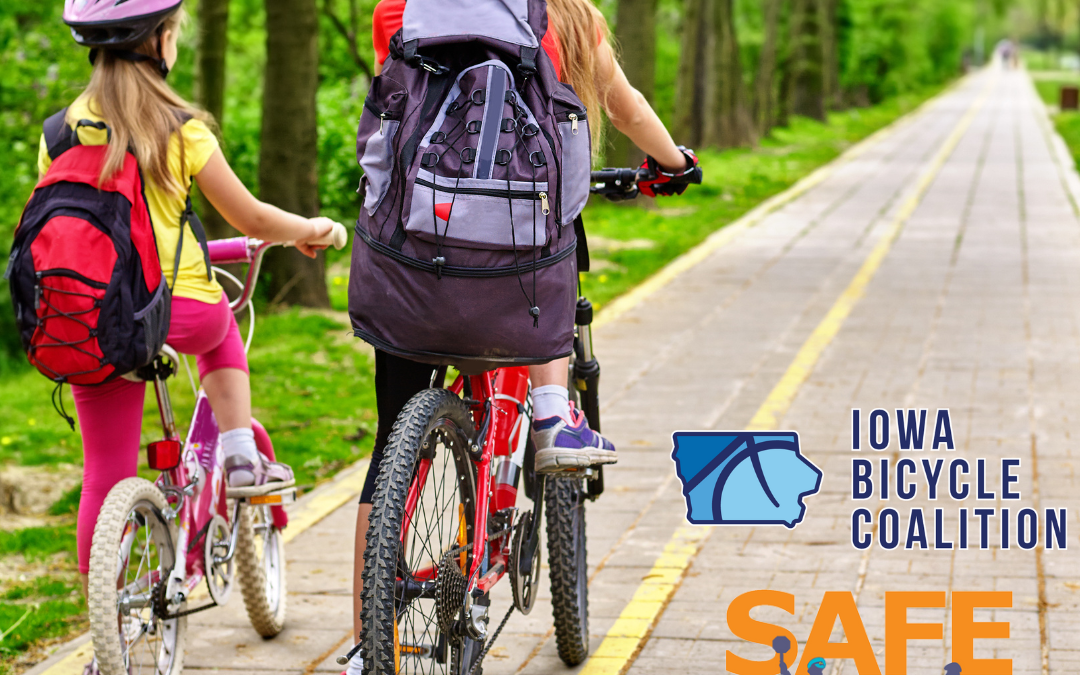We here at the Iowa Bicycle Coalition want more youth walking and cycling to work. But it takes more than education. More than bike helmets and reminding young pedestrians to look both ways. And doctors agree. The American Academy of Pediatrics, a renowned organization dedicated to promoting the well-being of children, has long been at the forefront of advocating for child safety.
In their latest announcement, the AAP emphasizes the importance of taking concrete steps to improve child pedestrian safety. This is their first policy statement on child pedestrian safety since 2009. It calls for communities to adopt and promote policies, programs, & legislation that result in a safer environment for pedestrians. The presence of high-speed traffic, lack of pedestrian infrastructure, poorly designed roadways, and inadequate traffic control measures increase the risk of child pedestrian injuries.
The AAP highlights the significance of educating children about pedestrian safety from an early age. Parents, caregivers, and schools play a crucial role in teaching children about traffic rules, proper road-crossing techniques, and the potential dangers they may encounter as pedestrians. We at the Iowa Bicycle Coalition are doing just that. Our Iowa Bike Rodeo Toolkit enables anyone to host a bicycle safety event to start teaching the youth how to navigate our roads safely. The toolkit can be adapted for a younger audience to go over pedestrian safety. But education is only one part of solving this dilemma.
Ensuring the safety and inclusivity of road environments is essential to cater to the needs of all individuals. Historically, streets served as vibrant spaces for various social activities, but with the rise of automobiles in the early 20th century, there was a significant cultural shift. Roads came to be seen primarily as thoroughfares for fast-moving motorized traffic. This perception was actively promoted through campaigns that attributed pedestrian injuries solely to the negligence of individuals. However, this narrow focus on individual behavior obscures the broader context in which these injuries occur, which involves factors such as speed, technology, and road design. By implementing effective planning and policy measures, we can create safer streets that cater to the needs of all users, regardless of age or ability.
Encouraging active transportation, such as walking or cycling, not only promotes physical activity but also offers an opportunity to teach children about pedestrian safety. The AAP recommends that communities support initiatives like walking or biking school buses, where groups of children move together under adult supervision, or establishing safe routes to schools. Community efforts can create a culture of active transportation while ensuring the safety of young pedestrians. These measures work best in communities where infrastructure is in place.
Creating a safe physical environment is vital for child pedestrian safety. The AAP calls for improved infrastructure that includes dedicated pedestrian pathways, properly maintained sidewalks, clearly marked crosswalks and strategically placed traffic signals. Policy changes also help, like many cities banning right turn on red or lowering school zone speed limits to 20 mph. Implementing these measures can help reduce the risk of accidents and create an environment that prioritizes the safety of our children.
The AAP emphasizes the importance of collaboration between policymakers, communities, and various stakeholders. By fostering partnerships and engaging in advocacy efforts, we can ensure that child pedestrian safety remains a priority on local, regional, and national levels. This collaboration can result in the development and enforcement of effective policies that protect children as pedestrians. We are doing just that by working with ongoing Safe Routes to School Committees like the one in Linn-Mar and starting a Safe Routes committee in Dubuque. These committees are committed to making safe routes to school via infrastructure changes where needed.
Worldwide there has been a drop in children’s independent mobility. Safe infrastructure is a critical part of getting kids moving again. “We know that active transportation, like walking or biking, is good for kids and it’s good for the environment,” said Brian D. Johnston, MD, MPH, FAAP, co-author of the report. “As children grow older, they will be able to be more independent. Each of us can help keep children safe by paying attention to the people around us and by promoting safer environments that benefit all of us.”
By focusing on education, safe infrastructure, active transportation promotion, and collaborative efforts, we can create an environment where children can navigate roads safely. And a street that is safe enough for a child is safe enough for everyone. Parents, caregivers, schools, communities, and policymakers need to work together to implement these recommendations and prioritize the well-being of our children. Doctor’s orders.
Want to host a bike rodeo in your own community? Download our bike rodeo toolkit today!
You can also support our efforts in expanding cycling education here. Link to AAP.

